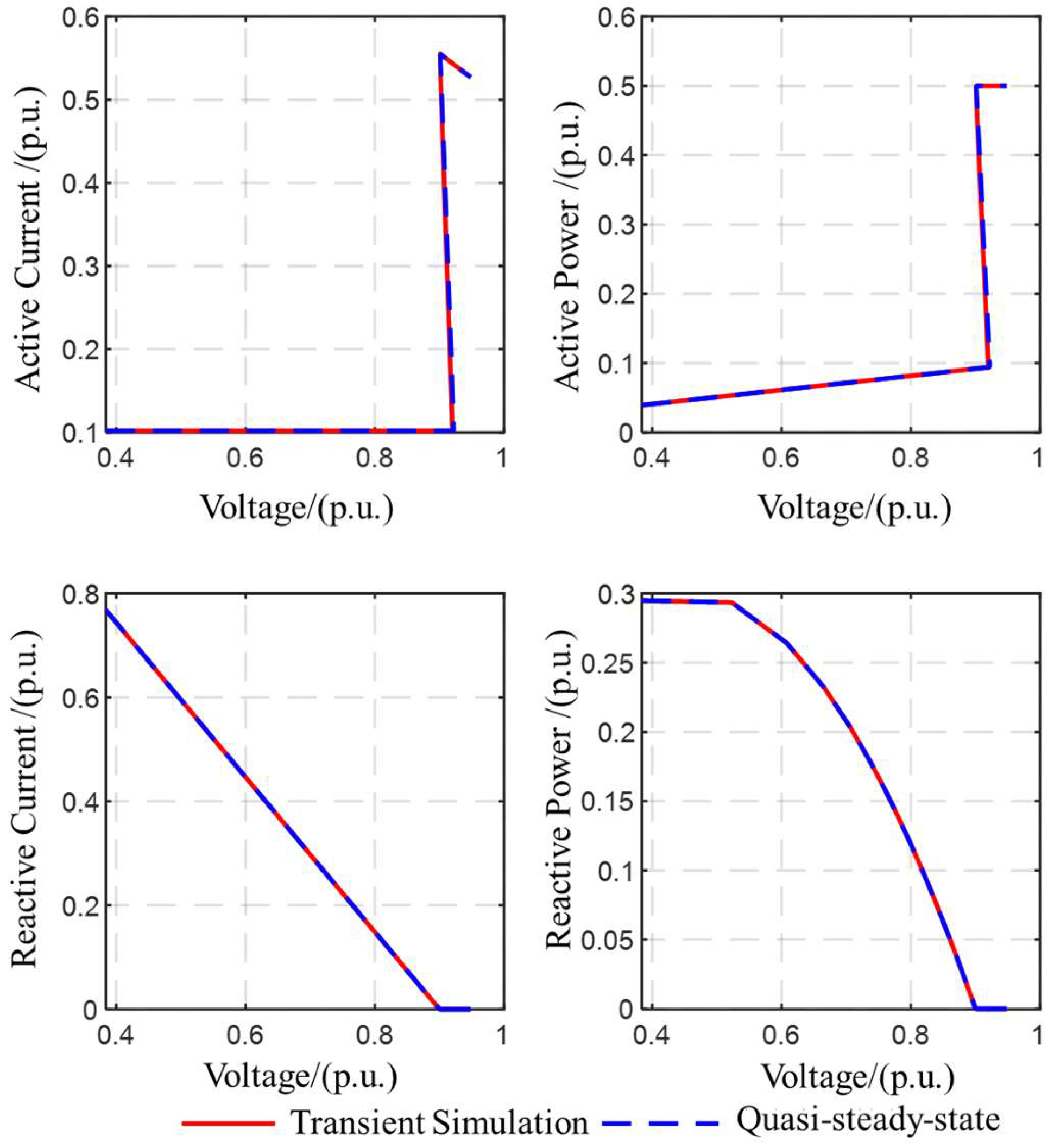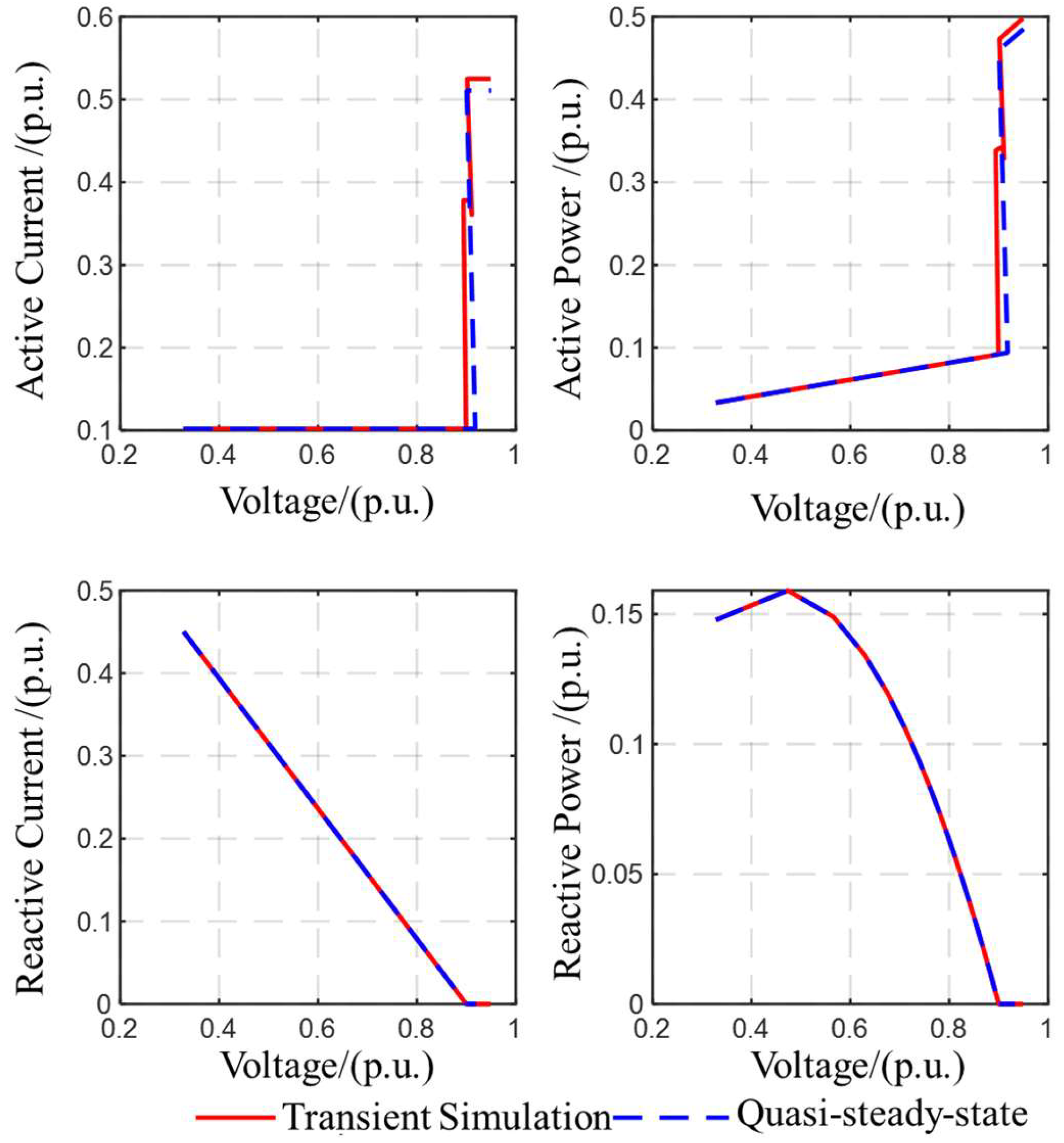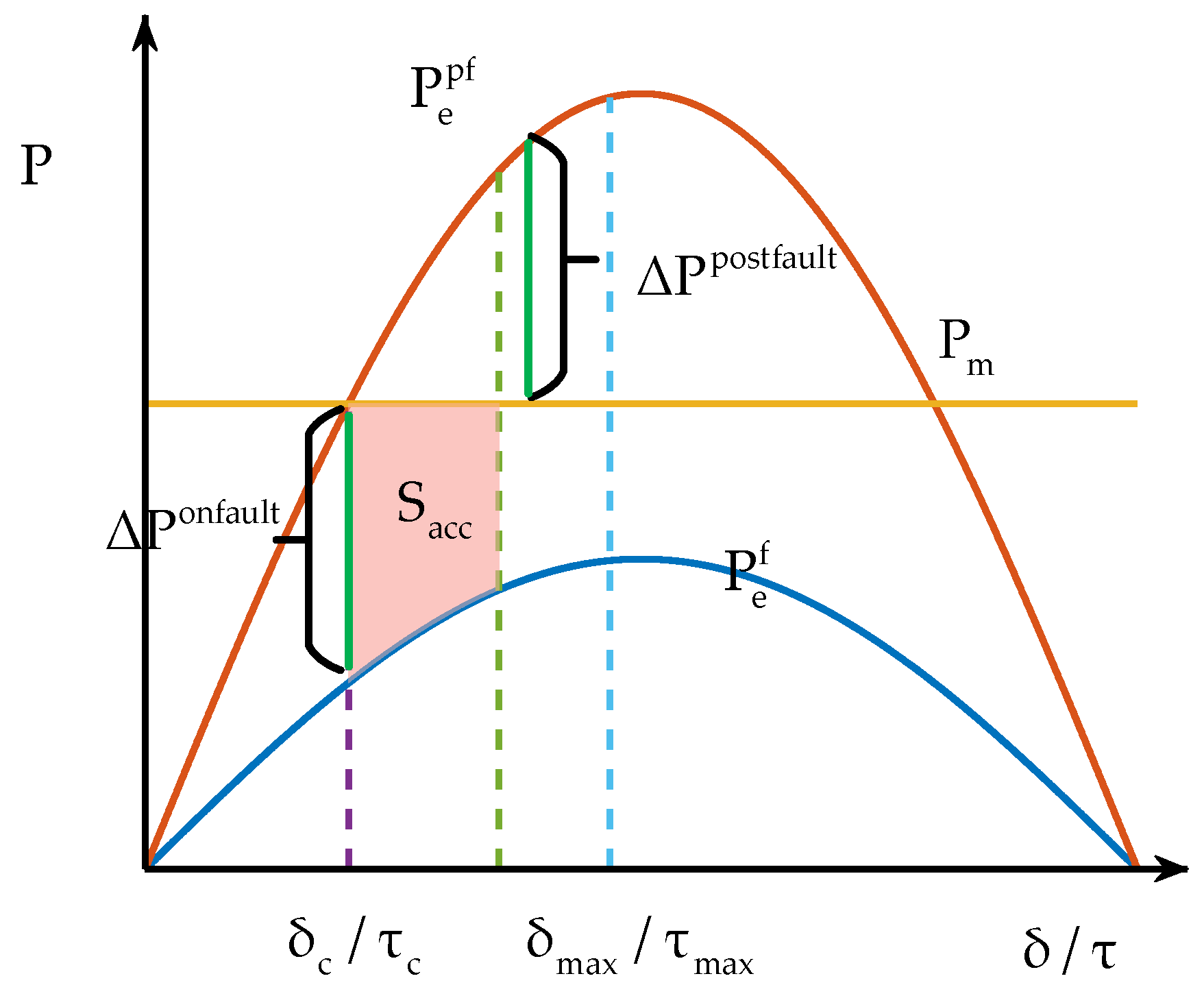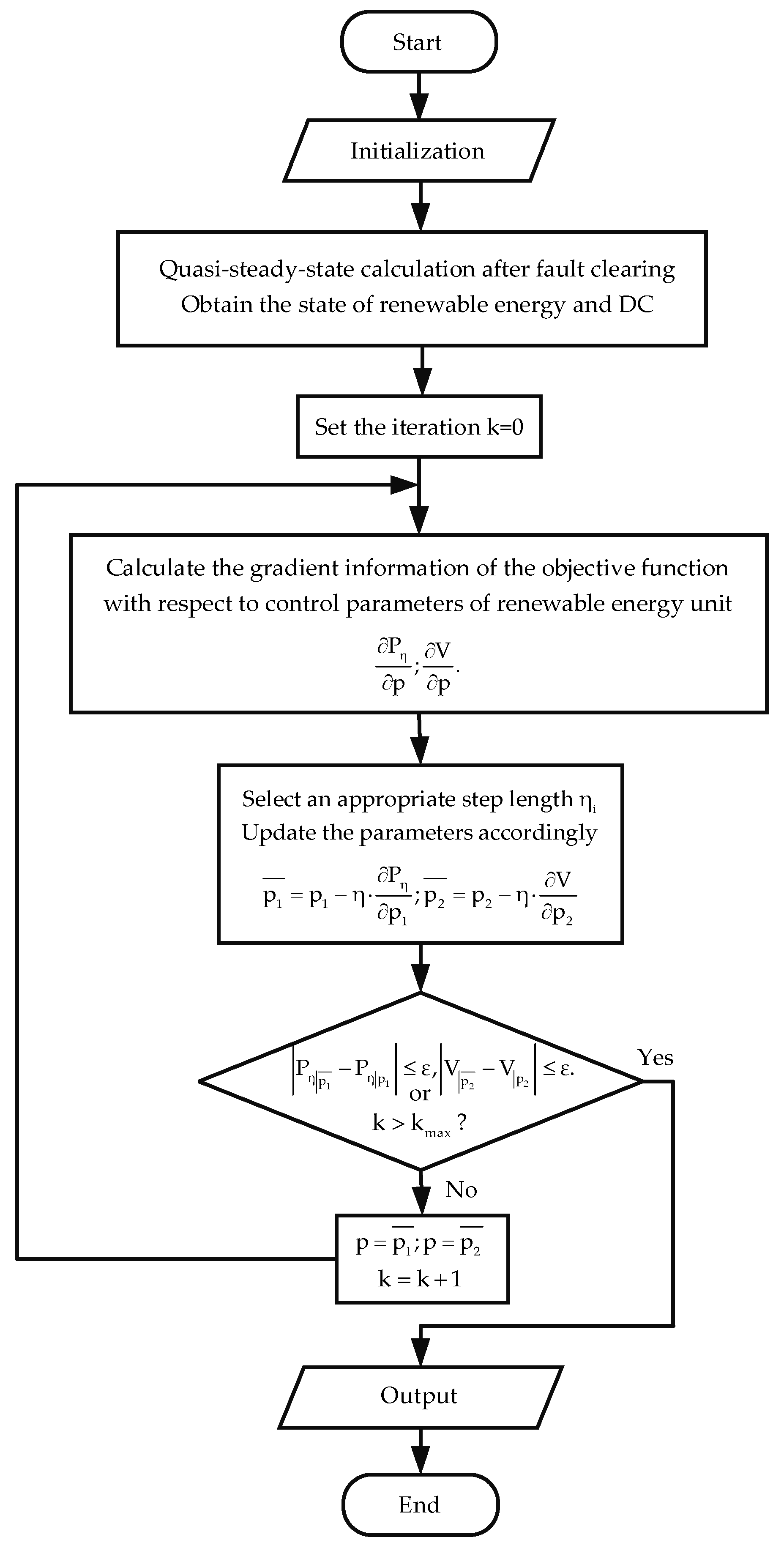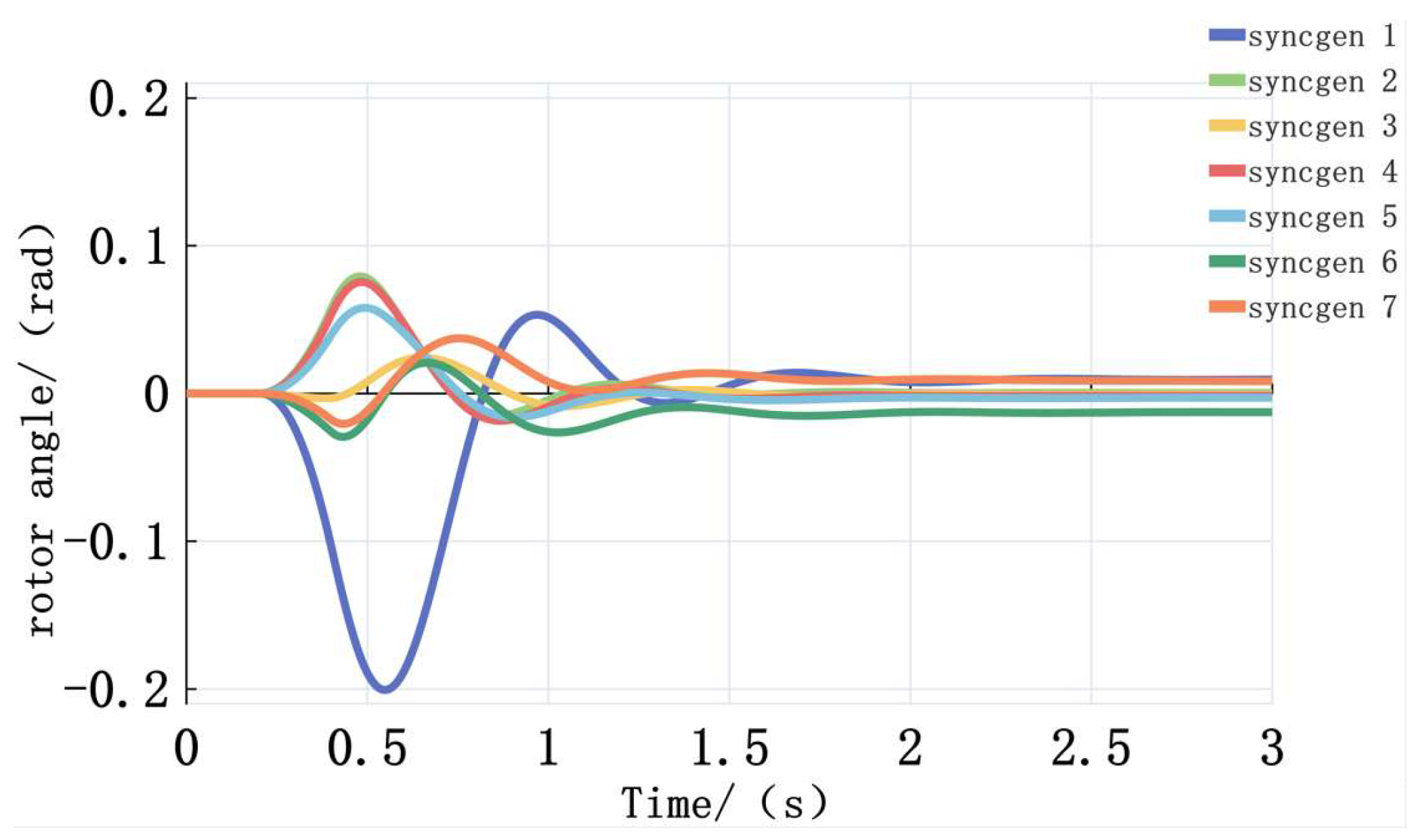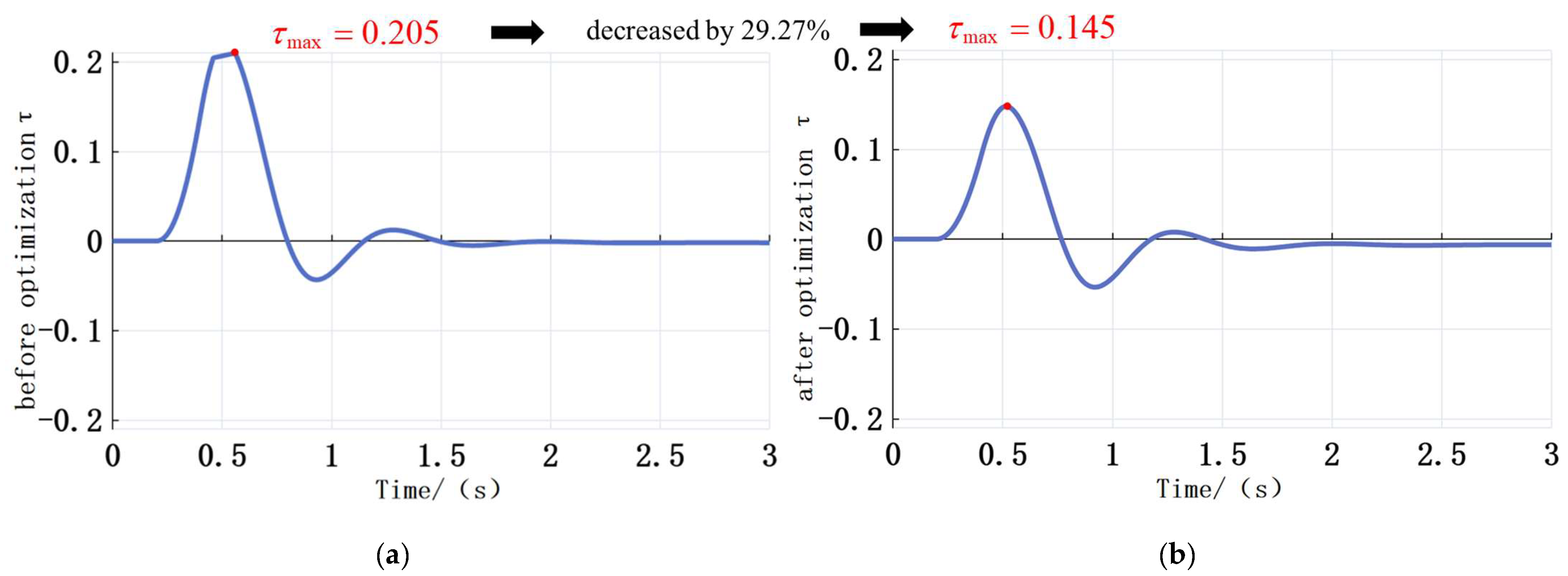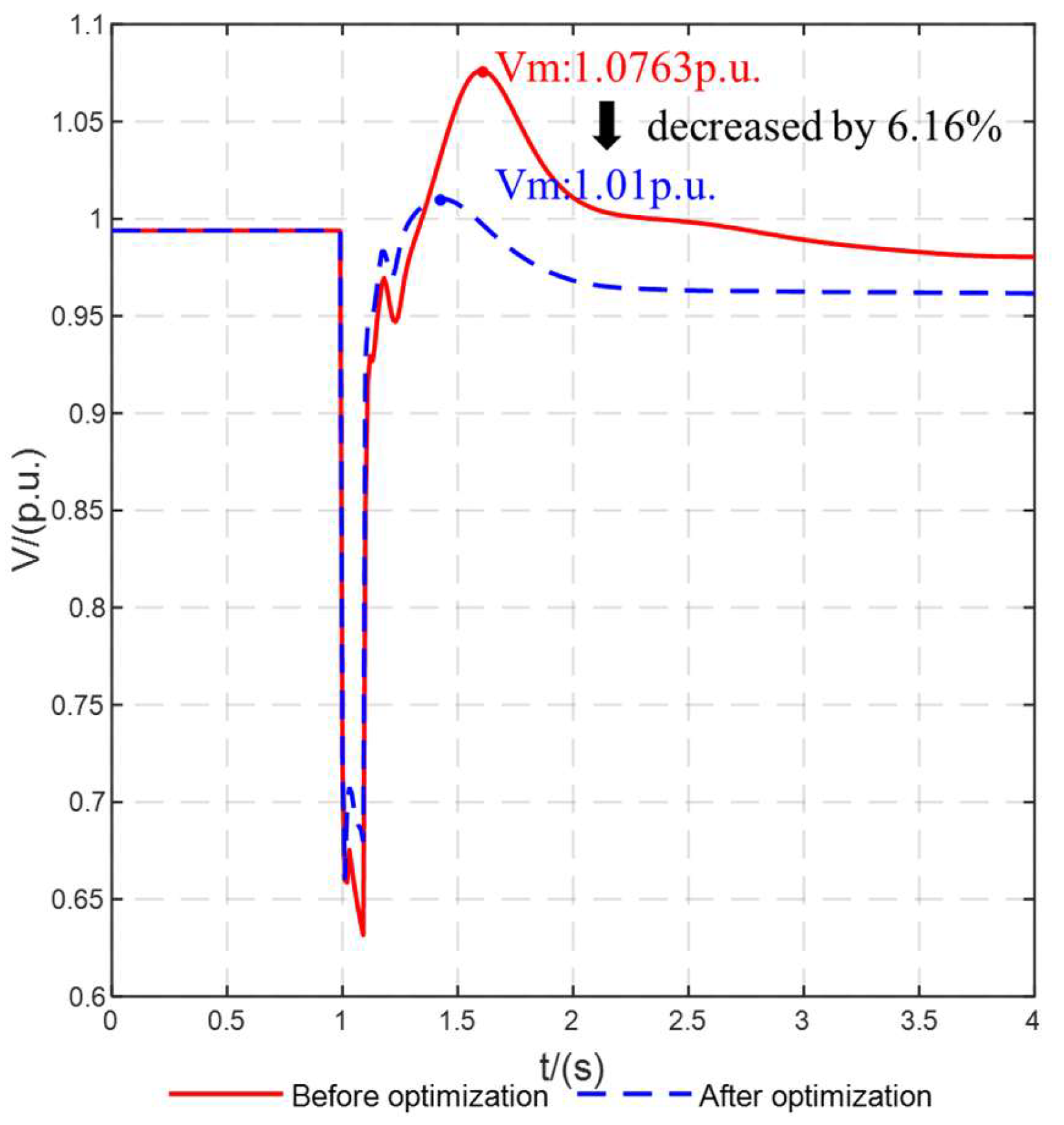2.1. Overview of QSS Model
The QSS model for modern power systems is founded upon the inherent property of timescale separation between electromechanical dynamics and electromagnetic transients. That is, each moment of the electromechanical transients corresponds to a quasi-steady-state equilibrium of the electromagnetic process. Given that the dynamic response of measurement and control in power electronic equipment is at timescale of electromagnetic transients, it is reasonable to represent the power electronics by quasi-steady-state models. Consequently, the differential model governing the underlying behavior of power electronic equipment gives way to a set of switched algebraic equations:
where the algebraic variable
is the internal operating state of the device, and the voltage phasor and the current injection phasor at the connection point of the device are denoted
and
, respectively. The possibly non-smooth and non-linear functions
and
capture the underlying physical law and the switching behavior of the device.
Meanwhile, the network equations are given by
where
Y is the network admittance matrix. Specifically, the injected current phasors
at each node can be calculated from the quasi-steady-state models of each component and be described as
where
,
and
are the injected current of synchronous generators, renewable generation units and loads in the xy coordinate frame. Their specific forms are detailed in
Section 2.3,
Section 2.4 and
Section 2.5, respectively.
By assigning different values to the internal states of synchronous generators, the proposed model can characterize various critical quasi-steady states, such as the instant immediately following a fault, the moment after fault clearing, and the post-fault steady state. Unlike conventional transient models, which rely on differential-algebraic equations, these reduced models consist of switched nonlinear algebraic equations. Solving these equations directly yields the desired critical quasi-steady states without requiring full time-domain simulations. Furthermore, variational analysis at these states provides valuable sensitivity information for control design and optimization.
2.2. Quasi-Steady-State Model of Renewable Generation Unit
As illustrated in
Figure 1, the converter control system is capable of transitioning between the standard operation mode and the FRT mode, depending on the voltage level measured at the point of common coupling (PCC). Under either normal operation or fault ride-through control, the renewable generation system connects to the grid via a voltage source converter (VSC) and operates in a current regulation mode governed by voltage control. For instance, under normal operation, a wind generation system employs coordinated control of optimal rotor speed, active power, and reactive power. In the QSS condition, the coordination between optimal speed regulation and active power management is expressed through an algebraic relation.
where
and
are, respectively, the measurement and reference of its rotational speed. In addition,
and
are the measurement and reference of the active power. Similarly to the active power control, the QSS model of the reactive power control takes the form
where
corresponds to the reactive power measurement, while
indicates its reference value within the control scheme. The current injection under normal control mode is given by
where
and
are the currents in local
coordinate. On the other hand, the current injection for the LVRT mode is usually a linear function of the voltage magnitude. The transient model features four active power control strategies and three reactive power control strategies; the control strategies are as follows:
The active current control method:
where
represents the axis current during the ride-through mode,
is the active current control setpoint,
denotes the total count of renewable energy plants and
represents individual current reference value for each renewable energy unit.
- 2.
Specified current as a percentage of the initial current control:
where
is the active current percentage setpoint and
is the initial active current.
- 3.
Specified power setpoint:
where
is the active power setpoint,
is the voltage of the point of interconnection and
is the capacity benchmark value of the power system.
- 4.
Specified power station initial power percentage control.
where
is the active power percentage setpoint and
is the initial active power.
Reactive current control method:
- 1.
Voltage-controlled reactive current control method.
where
represents the q axis current during the ride-through mode,
is the reactive current calculation coefficient,
is the LVRT threshold and
is the capacity benchmark value for each renewable energy unit.
- 2.
Specified power setpoint.
where
is the reactive power setpoint.
- 3.
Specified current control.
where
is the reactive current control setpoint.
Considering the transition between standard operation and LVRT modes, the current injection of the generation unit can be expressed as
where
represents the normal mode and
indicates the ride-through mode.
Considering that the d and q axes of renewable energy units are synchronized using a phase-locked loop (PLL), the injected current
of the renewable energy unit in the xy coordinate frame is determined by the following equation:
where θ is the phase angle corresponding to the voltage at the PCC.
To verify the QSS model of the described FRT control strategy, the case study adopts a single-machine infinite bus (SMIB) system integrated with renewable energy units (wind turbines or PV units). To validate the QSS representation of the proposed FRT control approach, the case study employs a single-machine infinite bus (SMIB) configuration coupled with RES, such as wind turbines or photovoltaic systems. A three-phase short-circuit fault is selected as the disturbance type, with fault initiating at 0 s and lasting for 10 cycles. The steady-state values of current and power in both the active and reactive components are selected for comparison. The corresponding results are illustrated in
Figure 2 and
Figure 3. The results indicate that the values are essentially consistent, thus verifying the correctness of the QSS model.
Specifically, regarding the active current, it remains constant at a relatively low level during the low-voltage ride through (LVRT) period. Under normal voltage conditions, wind turbines exhibit a decreasing characteristic, while PV units maintain a constant output. Furthermore, a recovery segment can be observed in the curve. This is primarily because after the fault occurs, the voltage begins to drop from the normal level. When it decreases to 0.9 p.u., the RES enter the LVRT state. At this point, the control strategy increases reactive power output to support voltage recovery, resulting in the voltage during the LVRT period occasionally exceeding 0.9 p.u. Additionally, in the transient simulation of the PV unit, the active current exhibits an intermediate value for a certain period. This occurs because the voltage fluctuates near the critical point of FRT, repeatedly entering and exiting the FRT state. As a result, the electrical quantities are actually in a periodic variation state rather than reaching a steady state, making it difficult to obtain their true steady-state values. The active power shows characteristics similar to the active current, but it exhibits an increasing trend during the FRT period. Under normal conditions, wind turbines implement constant power control, whereas PV units adopt constant current control. The reactive current curve demonstrates an initial decrease followed by stabilization, and the reactive power curve behaves similarly. However, at lower voltage levels (e.g., 0.5 p.u.), the rate of reactive power increase slows down, and in the case of photovoltaic units, the reactive power may even decrease.
2.3. QSS Model of Synchronous Generator
Under steady operating conditions, the electromotive forces (EMFs)
and
correspond to the d- and q-axis windings, respectively. The steady-state equation for the transient EMF of a synchronous generator is
where
and
represent the terminal voltage in the dq coordinate system of the generator,
and
represent the direct-axis and quadrature-axis transient reactance of the generator and
denotes the stator winding resistance.
To solve for
and
from Equation (17), we conclude
Considering that the synchronous machine’s dq reference frame is aligned with the rotor angular position, the injected current
of the synchronous machine in the xy coordinate frame is thus determined by the following equation:
For the instant immediately following a fault, the rotor angle δ remains unchanged at this moment since the synchronous machine controllers do not have time to respond. While for the moment after fault clearing, given the short duration of faults, the rotor angle can be assumed to change linearly.

